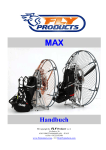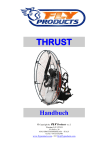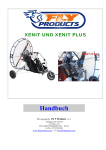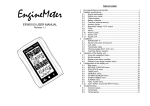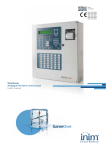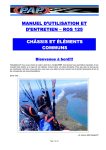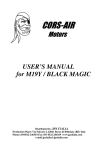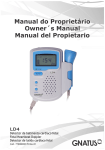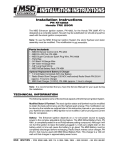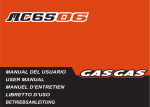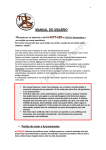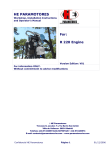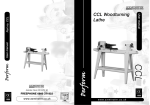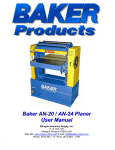Download GOLD 95/115/130 OWNER`S MANUAL
Transcript
GOLD 95/115/130 OWNER'S MANUAL © Copyright by FLY Products srl Via Perù n° 30 63013 GROTTAMMARE (AP) - ITALY tel/fax +39735632486 www.flyproducts.com - [email protected] GOLD 95/115/130 OWNER’S MANUAL 0 Chapter VER 10 Index Description 1.0 GENERAL INFORMATION 2.0 UNPACKING AND ASSEMBLING YOUR “GOLD 130-115-95” 3.0 PREPARING YOUR FIRST FLIGHT 4.0 FLYING YOUR NEW “GOLD 130-115-95” 5.0 OPTIONAL ACCESSORIES 6.0 PACKING YOUR “GOLD 130-115-95”FOR TRAVEL 7.0 MAINTENANCE 8.0 TROUBLESHOOTING 9.0 SPECIFICATION AND PERFORMANCE 10.0 MISCELLANEOUS © Copyright by FLY Products srl Page 2 GOLD 95/115/130 OWNER’S MANUAL VER 10 10 GENERAL INFORMATION Safety First! Powered Para Gliding (PPG) is the most exciting, least expensive, safest, most accessible form of aviation available! However, it is still aviation, and it brings with it all the inherent potential dangers of aviation People can, and do, get hurt, and even killed, in any form of aviation, including PPG For that reason it is imperative that all PPG pilots receive proper training from qualified instructors, offer PPG the respect all aviation deserves, respect weather and conditions, and realize that in the end, it is the pilot himself that is responsible for his own safety and the safety of fellow pilots and bystanders Powered Paragliding is an extremely demanding sport that requires exceptional levels of attention, judgement, maturity, self-discipline, and attention to detail It is unlikely that you will be able to participate in it safely unless you make a conscious and continual commitment to your own safety Due to the inherent risks in flying this or any PPG, no warranty of any kind can be made against accidents, bodily injury, equipment failure, and/or death This PPG is not covered by product liability insurance Do not start it or fly it unless you are willing to assume all risks inherent in the sport of Powered Paragliding and all responsibility for any property damage, injury, or death which may result from the use of this product Enjoy PPGing to the fullest, and welcome to the sport! Please read and be sure you thoroughly understand this Operator’s Manual before starting or flying your GOLD 95/115/130 It contains information critical to the safe operation of the Powered Paraglider Notation Used Certain special terms (NOTE, CAUTION, WARNING) will be used throughout this manual Their usage is defined below A NOTE provides supplemental information to help clarify a point being made in the text Generally, a “note” is provided to help assembly, use, or maintenance of the product Disregarding a “note” could cause inconvenience, but would not cause damage or personal injury A CAUTION provides supplemental information to help clarify an area where equipment damage could occur Disregarding a “caution” could result in permanent and significant mechanical damage, however personal injury is unlikely A WARNING provides supplemental information to help clarify an area where personal injury or even death could occur from negligence Disregarding a “warning” could result in serious injury or even death © Copyright by FLY Products srl Page 3 GOLD 95/115/130 OWNER’S MANUAL VER 10 20 UNPACKING AND ASSEMBLING Frame Assembly For an easy and correct assembly proceed in the following order: Step 1 Place the GOLD’s lower outer frame part on a flat surface and insert the central frame on it Hold down the lower outer frame with a foot and let the central frame descend into the four inserts connection points Step 2 : Assembling right hand side outer frame Insert the two lower pins of the side frame into their seatings Insert the side support forcing Lower connect Central connect Step 3 : Attach the velcro straps Once the frame is properly connected, it is best to immediately attach the velcro straps as shown Attach the central © Copyright by FLY Products srl Attach the middle Attach the lower Page 4 GOLD 95/115/130 OWNER’S MANUAL VER 10 Step 4 : Assembling left hand side outer frame Mount the left hand side outer frame repeating the previous step 2 When done, join upper frames inserts and lock with velcro strap Repeat step 3 on this side Attach the upper NOTE! When finished, check all velcro straps Attachments This completes the assembly of the prop cage Harness Mounting The harness mounts to the central frame with six attachment points They are: the top harness triangular carabiners, the ground handling straps, and the distance bars First connect the harness to the central unit by hooking the two triangular carabiners to the eyelets CAUTION – Close the carabiners immediately in order to avoid forgetting them later Ensure that the harness is attached correctly to the distance bars, and then insert them into their frame seats. Front harness webbing attachment © Copyright by FLY Products srl Distance bar attachment to the central frame Page 5 GOLD 95/115/130 OWNER’S MANUAL VER 10 Next, attach the two bottom harness straps as Fasten these belts securely Do this for the left and right sides Leave these straps at their loosest setting for now, we’ll adjust them later Bottom straps Close-up of mounting straps Fixing air box Air box Gold 95 Air box Gold 130 Harness Adjustment The harness consists of two separate strapping systems, one used to comfortably support the paramotor assembly unit on the pilot’s back while on the ground, and the other is used to support the paramotor and pilot while flying This system also correctly aligns the thrust angle of the prop In the the ground handling straps are in green, the flight straps are in red © Copyright by FLY Products srl Page 6 GOLD 95/115/130 OWNER’S MANUAL VER 10 Front and Side views of ground handling straps and the flight straps The two systems have separate purposes, and are adjusted separately Ground Handling Straps The ground handling straps as shown above are best adjusted standing on the ground, with the GOLD 95/115/130 on the pilot’s back The purpose of the shoulder straps and shoulder pads is to carry the weight of the GOLD 95/115/130 while on the ground The purpose of the ground handling chest strap is to keep the shoulder pads from sliding off the pilot’s shoulders when ground handling The adjustment procedure for the ground handling straps is as follows: Strap into the paramotor and stand up Adjust the Shoulder Straps until the shoulder pads are carrying the weight of the paramotor Attach snug the ground handling chest strap Adjust the thigh straps, the tightness of the thigh straps will determine how easily you can slide into the seat after takeoff , allowing the width of your hand between the strap and your leg is generally a good setting The ground handling straps are adjusted correctly if: The weight of the paramotor is on the shoulder pads The shoulder pads/straps won’t fall off the shoulders The seat can be moved out from under the buttocks easily You can easily slide into the seat after takeoff You can run easily and the seat and thigh straps don’t interfere with your ability to run © Copyright by FLY Products srl Page 7 GOLD 95/115/130 OWNER’S MANUAL VER 10 Flight Straps The purpose of each flight strap (are shown in red ) is as follows: Length “B” determines the carabiner height Higher accommodates larger pilots Lower accommodates smaller pilots and provides more weight shift capability This length has a variable adjustment locations Length “C” is adjusted by a buckle, and it sets the thrust angle Adjust it so the thrust angle is five to ten degrees below horizontal This must be done in a simulator See “Hang Test in a Simulator” below Length "D", is used to adjust the back of pilot's distance from the PPG Proceed to final adjusting of the harness in the simulator Set-up of flight straps Hang-test in a Simulator It is imperative that you perform a hang-test in a simulator before the initial flight of the GOLD 95/115/130, and every time you make a harness adjustment thereafter A simulator can consist of two ropes tied to a horizontal (and strong) tree limb, two ropes tied to rafters in your garage or basement, etc Once you have made your initial adjustments, strap into the GOLD 95/115/130 and clip the carabiners into the simulator Gently lift your feet and slide into the harness Continue to adjust the harness until the following criteria are met: The ground-handling straps should be loose and comfortable The ground handling chest strap should be loose (still buckled, but loose) No part of the harness should hamper free movement of your arms and the throttle cable Make sure you can reach your arms up very high with no strain or interference from the harness The propeller shaft must be approximately 5, and no more than 10, degrees below horizontal © Copyright by FLY Products srl Page 8 GOLD 95/115/130 OWNER’S MANUAL Seat set-up VER 10 Upper harness attachment Section A is the connection point for paramotore, point B instead serves only to connect with trike Flash is inadvisable to use it in paramotore foot lauch off the distance C must be done with the 30 cm to 33 cm. MENTION ON DISTANCE BARS: These distance bars are extremely easy to mount and dismount since they slide easily into the central frame The end of the distance bars are made of a square aluminum profile that does not allow them to rotate Due to the compression of the harness, the distance bars can not slide out of their fittings during flight ANTI-TORQUE SISTEM The distance bars are designed to allow the sliding of the front harness webbing so that the pilot finds the proper angle with the paraglider With this system the force of the propeller torque onto the risers is avoided Depending on the engine, the torque can be to the left or the right, in the case of SIMONINI engine the torque is to the right LATERAL MOVEMENT OF DISTANCE BARS The distance bars allow a lateral movement which is useful for the pilot to enter easily into the harness © Copyright by FLY Products srl Page 9 GOLD 95/115/130 OWNER’S MANUAL VER 10 This completes the harness mounting Double check your work to ensure that everything is OK Drive Before installing the propeller, make sure that the reduction (pinion) is the right one for your prop Drive 1:2,4 For wooden prop or props with a maximum diameter of 100 cm Drive 1:2,6 For carbon fiber propellers 2 blade or 3 blade. Prop Mounting NOTE: Here is some terminology we’ll use in this section The “front” is the direction the pilot faces while flying, the “rear” is the opposite direction The “front” of the prop can be identified by the thick side of the prop blades (leading edge) The “rear” side of the prop can be identified by the thin side of the prop blades (trailing edge) as the upper blade section shown in fig 17 The “rear prop flange” is the one that is most rearward when the prop is mounted The “front prop flange” is the one that is mounted on the reduction drive © Copyright by FLY Products srl Page 10 GOLD 95/115/130 OWNER’S MANUAL Mounting the prop is quick and easy: VER 10 mounting the prop Place the rear prop flange on the rear side of the prop Insert the six (6) prop bolts through the rear prop flange and prop Place the front thickness flange between the propeller and the reduction taking attention to fit the little centering hole in the prop Screw the bolts to the reduction drive and tighten them evenly The correct torque to use is 1 N m MAX A more practical “field method” of torquing is to tighten the bolts snuggly and evenly, but not enough to begin to crush the wood of the prop The red arrow in picture, indicate the direction of propeller rotation Assembly Inspection It is critical to fully inspect the assembly of the GOLD 95/115/130 to find and remedy any potential problem areas before proceeding The inspection should contain, at a minimum, the following items: Review each assembly step above Examine all nuts, bolts, and fasteners for security Check the harness for correct mounting, that all straps are secure, that there are no twists on any straps Examine prop cage for correct assembly, that it is strong, the netting is tight and on the correct side Check that nothing can get in the prop The prop should clear the cage by same distance at all points Check the fuel tank and fuel delivery system Check for correct mounting of prop, and correct torque of prop bolts © Copyright by FLY Products srl Page 11 GOLD 95/115/130 OWNER’S MANUAL VER 10 30 PREPARING FOR YOUR FIRST FLIGHT Fuel and Oil FLY PRODUCTS recommends the use of a premium unleaded automotive gasoline of 92 octane or higher, and the use of premium synthetic 2-cycle oil Mix fresh gas and oil before each flying session Store your fuel/oil mixture in an approved, sealed container Dispose of fuel/oil mixture that is older than 72 hours The recommended fuel/oil ratio is 2% Be sure to thoroughly agitate the mixture to completely dissolve the oil Use only fresh fuel and oil, and use clean containers, funnels, hoses, etc To fill the fuel tank, remove the fuel tank by unscrewing the fuel tank cap Take care not to get dirt, dust, etc onto the fuel pickup It is recommended that the fuel be poured into the tank using a straining-type of funnel Fill the tank with the desired amount of fuel and tighten the fuel cap securely NOTE: Wipe up any spilled fuel immediately, as the fuel/oil mixture is highly flammable, and an inflight fire would be catastrophic, also, the oil will leave a residue which will attract and retain dust and dirt WARNING! Use common sense when refuelling: Do not refuel a hot or running engine Do not smoke or allow on-lookers to smoke while refueling Do not refuel near heat or open flame Before Starting the Engine Before starting the engine on the ground, ensure that the unit is in an area free from dirt, rocks, dust, etc that could be sucked up and thrown around by the propeller Check assembly of the unit, and especially check any and all nuts, bolts, and screws, that could be loose Also check all parts of the prop cage for looseness The prop produces a significant amount of thrust, and can suck things into it from a surprising distance WARNING! Ensure that no bystanders or onlookers are close by when starting the motor The most dangerous place to stand is in the plane of the propeller This is where dust, dirt, rocks, nuts, bolts, etc, will be thrown if they are picked up by the prop At full RPM, the prop tips are moving in excess of 370mph, and pushing the air rearward at over 70mph This amount of force can pick up anything loose in the area and throw it around like a bullet Not only can it severely injure you or bystanders, even small items like dirt can inflict significant damage to the prop Starting and Stopping Engine Stopping the Engine Before proceeding it's better to learn the function of the handgrip: © Copyright by FLY Products srl Page 12 GOLD 95/115/130 OWNER’S MANUAL VER 10 A – “STOP” button B – “START” button C – Throttle lever D – Cruise control setup E – Velcro strap Multifunction handgrip Since it’s important to know how to stop the engine once it’s started, let’s cover “Stopping the Engine” first To stop the engine, simply depress the “STOP” button (A - fig 18) and hold it until the engine comes to a complete stop It is important to be aware of some other engine stopping techniques, should the stop switch not function correctly The stop switch may not function correctly due to 1) faulty switch, 2) broken wires, 3) bad connections to any part of the stop switch circuitry For this reason, the following emergency stop procedures are available: To stop the engine if the stop switch doesn’t function correctly, you can Unplug the electric cap of the spark plug (there is a big risk to take an electric-shock, not dangerous but unpleasant) Squeeze the fuel line (requires an aggressive squeeze, and takes about two minutes to stop the motor) Starting the Engine Now that we’ve covered stopping the motor, let’s start the engine! Check that the fuel tube is full, if it isn't, use the designated fuel pump to fill it up Be careful to not pump more than necessary to avoid engine flooding To start the engine cold it's necessary to inject fuel into the cylinder, to do this, squeeze the pump only once while holding the accelerator completely open until you hear the fuel squirt from the carburetor into the cylinder Allow a certain quantity of fuel to enter the carburetor but not enough to allow it to go out of the air filter If this happens, this means that the engine could be flooded and will hesitate to start © Copyright by FLY Products srl Page 13 GOLD 95/115/130 OWNER’S MANUAL VER 10 If everything is ready as described in the procedure preloads, proceed to place the main lever of breakers security position . We’ll cover each of these starting options in turn If the engine is cold it's very important to fill the fuel lines squeezing the primer bulb placed near the fuel tank to inject some fuel into the cylinder - Standing in front of the unit, holding the unit on the ground WARNING! The method of holding the throttle handle is important in this position Hold the throttle handle such that you can easily reach the stop button, but not so that you can inadvertently squeeze the throttle (do not strap your hand to throttle at this point) A common accident can happen where you hold the throttle in the same hand that you hold the motor unit, and if you squeeze the throttle a little, the thrust of the machine will push the throttle onto your hand, causing you to squeeze the throttle even more Make sure that you CANNOT inadvertently squeeze the throttle handle when starting in this position - Stand in front of the unit, and place your left hand on the top of the central frame tube Hold the throttle in your right hand , noting the warning above - Depress the START button until the engine starts The engine should start after a few propeller turns - Strapped into the unit, standing on the ground Just depress the START button once you are ready, strapped and standing on the ground - In flight One very valuable feature of the GOLD series is its ability to be started while in flight This feature allows the pilot the freedom to turn-off the engine and glide silently, to enjoy the exhilaration © Copyright by FLY Products srl Page 14 GOLD 95/115/130 OWNER’S MANUAL VER 10 of thermal soaring, and then when he gets low, re-start the engine pressing the START button and climb back up to do it again WARNING! It's very important that immediately after landing, or when the equipment is not in use on the ground, to turn the main security switch to the OFF position to avoid an accidental starting of the engine with unpredictables results! Carburetor Adjusting To adjust the idling, turn the screw shown in Fig The screw sets the revs at idle, by opening or closing the butterfly valve Choke lever is used only for cold engine starting, do not leave it “ON” for long time to avoid a flooded engine Carburetor WALBRO WB 37 Carburetor Adjusting Standard carburetor setting When purchased, the motor has a standard carburetor setting and testing. To modify, this one must adjust the two screws of the carburetor. The screw on the right marked with a L (low) regulates the entrance of fuel at the low speed (the range of the accelerator from zero to half). The screw on the left marked H (high) regulates the air fuel mix higher speeds. It is extremely important to both maximum engine efficiency and engine life, to understand and keep in tune your carburetor setting. There are two fuel to air carb setting which function in the following manner: L screw adjust: rotate (clockwise until completely closed). © Copyright by FLY Products srl Page 15 GOLD 95/115/130 OWNER’S MANUAL VER 10 Now carefully open the screw counter clockwise 1turn (turning the screw out in the counter clockwise direction enrich the mix/fuel to air ratio). This is the standard factory setting for L. With the H (meaning High rpm) screw follow the same procedure and turn it clockwise until full closed. Now paying close-attention, open the H screw 1 turn to arrive at the standard factory setting. Keep in mind that these setting are extremely sensitive and the total sum of all adjustment you make to the screw should not exceed ¼ of a turn. Increments of 1/10th of a turn are already sufficient to change engine performance. In particular be careful not to run your machine at the “too poor” of a fuel to air-mixture, as this can result in possible overheating and engine damage due to lack of cylinder lubrification. Pay much attention to the carburator setting at the maximum since if this mixture is too poor, it can result in engine damage. No damage is done if the setting is too rich. Therefore, when in doubt, it is better to have carburation, at the maximum rpm, somewhat more on the rich side. A verification of carburation can be done after the engine has run 20-30 minutes checking of the colour of the spark plug electrode. If the electrode is brown the carburation is correct. If is grey, its poor and if its is black its rich. Attention: If the carburation should happen to be difficult to adjust by listening to engine runs, this means that the fuel tube is absorbing air from the pump (in this case is better to change it) or else from the connections between the tank and the carburator. The air bubbles are easily seen, while the engine is running they are seen passing through the tube. THE WB 37 IS EQUIPED WITH 3 SETING SCREWS: 1 H for high. Controls the mixture at full load 2 L for low. Controls the mixture in the lower and medium speed range 3 Controls the idle © Copyright by FLY Products srl Page 16 GOLD 95/115/130 OWNER’S MANUAL VER 10 Engine Break-In Break-in of the GOLD 95/115/130 SIMONINI engine is required before the first flight Proper break-in will provide you with a better running engine, it will also provide for considerably longer engine life During the break-in, gently change RPM from idle to 3/4-throttle and back The procedure is as follows: Run the engine, varying the RPM, for 2 minutes Stop the engine and let it cool off for 2 minutes Check for loose bolts, etc during this time Run the engine, varying the RPM, for 5 minutes Stop the engine and let it cool off for 5 minutes Check for loose bolts, etc during this time Run the engine, varying the RPM, for 10 minutes Stop the engine and let it cool off for 5 minutes Check for loose bolts, etc during this time Continue 10 minutes of running, 5 minutes of cooling until 30 minutes of run time is achieved At this point, you can fly the GOLD 95/115/130, however avoid long periods of full power, and vary the throttle setting often For heavier pilots that require more power to fly, it is recommended that 1 hour of non-flying break-in be completed before flying Break-in is complete after 10 liters of fuel have been run through the engine Avoid to use ready fuel mixture from services area If is possible, do the mixture yourself with an appropriate % of oil and the correct gasoline Avoid using mixture two weeks old or more 40 FLYING YOUR GOLD 95/115/130 Pre-flight inspection Before your first flight, and before every flight, it is absolutely essential to perform a pre-flight inspection on your aircraft WARNING! Failure to perform a sufficient preflight has been a contributing factor to accidents in all kinds of aircraft Equipment damage, bodily injury, even death can occur due to equipment problems not caught in a preflight inspection As the saying goes, “Preflight as if your life depends on it, because it does!” © Copyright by FLY Products srl Page 17 GOLD 95/115/130 OWNER’S MANUAL VER 10 NOTE! Example of pre-flight checklists can be found at the end of this manual It is highly recommended that you use one of the examples, or create your own, print it out, laminate it, and use it whenever you fly Also note that these Checklists are examples only, FLY PRODUCTS is not responsible for their use or for their completeness 50 OPTIONAL ACCESSORIES Tool Kit It is highly recommended that a tool kit be assembled and carried in one of the harness pouches The following tools, at a minimum, are suggested for the tool kit: Spark plug wrench (13/16”) Metric Allen wrenches Vice Grips Combination wrenches (10mm, 13mm) Screwdrivers (both Phillips and Straight) Reserve Parachute A reserve parachute can be fitted to the GOLD 95/115/130, and is a highly recommended safety item Many different mounting locations and methods are possible and acceptable, and the one you choose depends on many things such as which hand you want to deploy with, what type of reserve you have, where you prefer to mount it (front, left or right side), etc For this reason, FLY PRODUCTS cannot make a generalized statement of what the best mounting configuration is for you It is highly recommend that you seek assistance from your PPG instructor on the mounting of your reserve parachute It is also highly recommended that you receive training (a reserve parachute clinic) covering topics reserve deployment topics such as reserve re-packing and parachute care, performing a PLF (Parachute Landing Fall), and when to make the decision to deploy your reserve WARNING! A reserve parachute is a life-saving backup system, to be used in life-threatening emergencies only A reserve parachute should never be deployed “for fun” or to “see what it’s like” A reserve parachute deployment is an extremely dangerous event You surrender control over your aircraft, you have no choice as to your landing location and could land on rocks, roads, Power lines, etc Even with a correctly deployed parachute, your impact speed with the ground is significant Also, reserve parachutes are not guaranteed to deploy correctly Remember the expression, “A reserve parachute isn’t your second chance, it’s your last chance” Carry a reserve parachute, and deploy it only if it is absolutely necessary © Copyright by FLY Products srl Page 18 GOLD 95/115/130 OWNER’S MANUAL VER 10 Speed Bar A speed bar can be mounted to the GOLD 95/115/130 harness Optional pulleys can be added to the harness to facilitate the application and routing of the speed-bar These pulleys can be obtained from your GOLD 95/115/130 dealer 60 PACKING YOUR GOLD 95/115/130 FOR TRAVEL Disassembling for local travel For local travel in a car, only partial disassembly is necessary This disassembly includes removing the prop cage and prop Disassembling and packing for long-distance travel Disassembly and packing for long-distance or airline travel requires complete disassembly of the GOLD 95/115/130, and then packing into a suitably padded and protected box for travel Fuel Tank drain For airline travel, make sure you completely drain the tank, and wipe the inside dry by inserting a paper towel and thoroughly drying tank NOTE! Make sure you check, and comply with FAA regulations as well as regulations of the specific airline that you are traveling before taking the machine aboard an airliner Draining All Fuel With the fuel tank completely drained, start the engine and allow it to idle until it stops running At this point, all of the fuel will have been removed from the carburetor and fuel lines Removing The Harness Unlock the top two harness triangular carabines Remove the distance bars from their seating Remove the ground handling straps by threading the lower straps up through the buckles This completes the harness removal Cage Disassembly Remove the cage in the inverse order as described before © Copyright by FLY Products srl Page 19 GOLD 95/115/130 OWNER’S MANUAL VER 10 70 MAINTENANCE Periodic maintenance is required in order to keep your GOLD 95/115/130 in top operating condition The following chart provides the suggested maintenance schedule Table 1 INTERVAL INSPECT During and after Break-In All screws, nuts, bolts, prop cage, netting, harness webbing, etc Every 5 hours REPLACE All screws, nuts, bolts, prop cage, netting, silent-blocks, reduction belt, etc Spark Plug, check color is light brown Check spark plug cap Every 25 hours All screws, nuts, bolts, prop cage, netting, etc fuel filter Clean, re-gap spark plug De-carbonize Cylinder head Every 50 hours Spark Plug reduction belt Piston ring, piston pin, piston pin bearing and pin keepers Every 100 hours Secondary pulley bearing Every 200 hours Crankshaft bearings © Copyright by FLY Products srl Piston and cylinder assembly, all bearings and crankshaft seals Page 20 GOLD 95/115/130 OWNER’S MANUAL Yearly (regardless of hours) Fuel pump and carburetor diaphragms Crankshaft seals and condition of all plastic and rubber parts VER 10 Fuel hose, fuel filter, reduction belt, silent-blocks Cleaning Clean your GOLD 95/115/130 with clean water and a mild soap Dust and dirt can be brushed off, or removed with water and mild soap Grease and oil can be removed with a good water-based degreaser such as “Simple Green” Prop Care Avoiding Prop Damage It is very easy to damage the propeller by sucking up dirt or rocks when running the motor on the ground To avoid this, either place the unit on a sheet of plywood or something similar, or use a nice clean area such as a nicely mowed yard An alternative is to strap the motor on and start it in the standing position Prop Balancing Balancing of the propeller is very critical The prop blades are subjected to accelerations as high as 2000 G’s! Therefore, a weight difference of only 1 gram can cause forces as high as 2kg This force will cause a vibration at the speed of the propeller RPM, and can cause enough vibration to break welds or tubes of the frame Therefore, correct prop balance is of the utmost importance Keeping the Prop Clean Wipe all dirt and oil from the prop when finished flying Oil, if left on the prop for long periods of time, can seep into the wood and cause an imbalance Store the Prop Horizontally When storing the paramotor, rotate the prop to a horizontal position This is because if the prop is stored vertically, moisture and oils in and on the prop can migrate downward and cause prop imbalance This phenomenon can only happen on wood props Spark Plug The recommended spark plug for the GOLD 95/115/130 motor is the NGK B9ES or NGK B10ES Spark plug gap is 0025” (0635mm) Recommended cleaning and gapping interval is every 25 hours Recommended replacement interval is every 50 hours © Copyright by FLY Products srl Page 21 GOLD 95/115/130 OWNER’S MANUAL VER 10 Repairs Minor repairs can be performed on the prop, cage, cage guard, and harness Major repairs should be performed by a trained service technician, or by FLY PRODUCTS Caution! Repairs to the harness or any stress-carrying areas of the GOLD 95/115/130 should only be performed by a certified parachute rigger Reduction belt ADJUSTING REDUCTION BELT Attention: Only qualified people are able to do this procedure, consult your dealer The reduction belt is regulated by the manufacturer In case of it stretching, which is noticeable by a whistling sound and a harsh increase in runs when accelerating, it should be adjusted This happens most likely when the engine is cold and when there is a high level of humidity in the air Proceed as shown in Fig 27 with a 6 mm and a 10 mm allen screw keys: Loose bolt A Turn clockwise bolt B to increase belt tension Tight bolt A Long Term Storage Long Term Storage is defined as anything longer than 3 months The long-term storage procedure is as follows: Fuel tank drain completely Start and run engine at idle until it stops from fuel starvation This is to remove all fuel from the carburetor and lines Remove spark plug Inject 4 teaspoons of 2-cycle oil into the spark plug hole Gently pull the starter rope a few times to distribute the oil, then reinstall the plug Clean the prop of any dirt and/or oil Clean the cage, harness, etc so that it is free from dirt and/or oil Cover the machine with a sheet or light cloth © Copyright by FLY Products srl Page 22 GOLD 95/115/130 OWNER’S MANUAL VER 10 Store in a clean, dry place 80 TROUBLESHOOTING Diagnosing and starting a flooded engine A flooded engine can be identified by the smell of unburned gasoline coming from the exhaust pipe, or by periodic weak firing and puffs of black smoke during starting attempts If you have a flooded engine, follow the procedure below: Remove the spark plug and thoroughly dry it (Note another indication of a flooded engine is a spark plug that is dripping with gas) With the spark plug removed push the starter button for a few seconds while holding the throttle in the full-open position This will remove excess fuel from the engine Install the dry spark plug, and start using the normal procedure WARNING! Ensure you have placed the spark plug cap away from all fuel sources before pulling the starter cord or a fire could occur! WARNING! Do not use a flooded engine procedure whereby you hold the throttle wide-open and then attempt to start the engine If the engine were to start, the prop would rapidly spin to full RPM and damage or injury would most likely occur! Troubleshooting Chart SYMPTOM Engine does not start POSSIBLE CAUSES SOLUTIONS No fuel in tank Fill tank per fueling instructions Fuel pickup does not reach all the way to bottom of tank Inspect fuel pickup and ensure that it reaches the bottom Spark Plug cap not in place Ensure spark plug cap is installed Insufficient battery power Recharge battery Fouled Spark Plug Inspect plug, clean and re-gap, or replace with a new plug Incorrect Spark Plug Gap Gap the plug to 0025” (0635mm) Engine is flooded Follow procedure outlined in section 81 Engine starts, but does not continue to run © Copyright by FLY Products srl Page 23 GOLD 95/115/130 OWNER’S MANUAL Excessive Vibration VER 10 Prop out of balance See section 72 Loose fasteners mounts or attachments Check and tighten engine mounting bolts, muffler bolts, prop bolts, etc 90 SPECIFICATIONS AND PERFORMANCE Specification and Performance Summary Chart ITEM SPECIFICATION Engine Make and Model Simonini G24 Engine Type Single cylinder, air cooled Displacement / Bore x Stroke 202 cc / 66,4mm X 58mm HP (GOLD with special exhaust) 28,5 HP Carburetor Bing - Walbro Rotation Direction Counter-clockwise ( as viewed from rear) Air Cleaner Silenced air box Spark Plug NGK B9ES(cold places) B10ES (Warm places) Fuel Premium auto gas, 92 Octane or higher Fuel/Oil Ratio 2,5 Starting System Electric starter Prop 2 blade Thrust ( model) 130 lb(M115) -180 lb(M130) Climb rate 400 – 800 ft/min with a DHV 1-2 wing Frame Aluminum, aircraft tubing Harness Rip-stop nylon Dry Weight 64 - 68 lb Fuel Tank Capacity 45 gallon Estimated fuel duration 3 hours, with a 170lb pilot Maximum Pilot or Pilot/Passenger 395 lb (185 kg) © Copyright by FLY Products srl Page 24 GOLD 95/115/130 OWNER’S MANUAL VER 10 (tandem version) weight Max RPM 7300 RPM Reduction system / Reduction ratio Belt / 2,37:1 2.6:1 Torque Specification Chart ELEMENTS TORQUE (Nm) Cylinder head bolts ( M8 ) 28 Magnet fixing nut ( M12 ) 42 Reduction cam locking screw ( M8 ) 28 Primary pulley locking screw ( M12 ) 45 Exhaust bolts ( M8 ) 28 Propeller bolts ( M6 ) 10 © Copyright by FLY Products srl Page 25 GOLD 95/115/130 OWNER’S MANUAL VER 10 Electric system Following table shows the GOLD ‘s electric connections : © Copyright by FLY Products srl Page 26 GOLD 95/115/130 OWNER’S MANUAL VER 10 Electric connections table 1 - 12V battery 2 – Electric starter 3 – Main switch 4 - Relay 5 – Battery charger 6 – Handgrip plug 7 - Low fuel level float 8 – Stator © Copyright by FLY Products srl Page 27 GOLD 95/115/130 OWNER’S MANUAL VER 10 9 - Spark coil 100 MISCELLANEOUS Obtaining Repair Parts To obtain repairs parts for your machine, call your FLY PRODUCTS local dealer or FLY PRODUCTS directly G24 - ENGINE SPARE PARTS © Copyright by FLY Products srl Page 28 GOLD 95/115/130 OWNER’S MANUAL CODE VER 10 Description © Copyright by FLY Products srl Page 29 GOLD 95/115/130 OWNER’S MANUAL G24-01 G24-26 G24-02 G24-27 G24-03 G24-29 G24-04 G24-30 G24-05 G24-33 G24-06 G24-34 G24-07 G24-35 G24-09 G24-36 G24-10 G24-37 G24-11 G24-38 G24-12 G24-40 G24-15 G24-41 G24-17 G24-42 G24-17A G24-46 G24-17B G24-46A G24-20 G24-47 G24-21 G24-50 G24-23 G24-51 VER 10 Battery charger Starter crown Coil Nut and washer Long head nut Poly-v belt Cylinder head Prop plate with bolts Cylinder head gasket Pulley Studs (cylinder) Pulley thickness washer Cylinder Pulley bearings set Silent-block set bearings thickness rings Engine crankcase Pulley seeger Bolt set Cam pin Vacuum tube fitting Oil seal ring set Air filter Crankshaft bearings set Carburator Complete crankshaft Carburator fitting Complete piston Air filter fitting Piston rings set Header with ring-screw Stator and flywheel Laminar pack Stator support Electric starter Pinion gear Warranty © Copyright by FLY Products srl Page 30 GOLD 95/115/130 OWNER’S MANUAL VER 10 FLY PRODUCTS will warrant their product to be free from defects in materials and workmanship for a period Twelve (12) months months from the date of purchase This warranty applies to the product in normal usage situations only The dealer, from whom you purchased the product, or FLY PRODUCTS, will repair the product free-of-charge To obtain warranty service, please contact your dealer or FLY PRODUCTS, and then either bring the product in or have it shipped Shipping charges are the responsibility of the purchaser This warranty does not apply even during the warranty period, and the purchaser shall pay repair or replacement charges if: The cause of malfunction is due to misuse, neglect, negligence, etc This includes seize of the engine due by an improper carburetor adjustment or improper fuel/oil mix The malfunction is caused by incorrect pilot operation, ie a crash, whack, dork, bang, splat, ding, prong, bend, tweak, trip, fall, bounce, or any other piloting eventuality The malfunction is caused by lack of normal maintenance, or modification, ie loose parts falling off and breaking the prop The malfunction is caused by an Act of God, including but not limited to fire, hurricane, earthquake, flood, or other natural calamity © Copyright by FLY Products srl Page 31 GOLD 95/115/130 OWNER’S MANUAL VER 10 Internet info and upgrade For information, more details and news see our internet site: www.flyproducts.com For safety information , data and rules you can visit the DULV website: www.dulv.de © Copyright by FLY Products s.r.l. Via Perù 30 63013 GROTTAMMARE (AP) - ITALY tel./fax +39.735.632486 www.flyproducts.it - [email protected] © Copyright by FLY Products srl Page 32

































